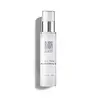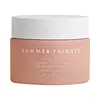What's inside
What's inside
 Key Ingredients
Key Ingredients

 Benefits
Benefits

 Concerns
Concerns

No concerns
 Ingredients Side-by-side
Ingredients Side-by-side

Water
Skin ConditioningGlycerin
HumectantGlycine Soja Extract
Skin ConditioningSodium PCA
HumectantProline
Skin ConditioningCarbomer
Emulsion StabilisingPanthenol
Skin ConditioningAspartic Acid
MaskingGlycine
BufferingSodium Lactate
BufferingHyaluronic Acid
HumectantNiacinamide
SmoothingCalcium Pantothenate
Sodium Ascorbyl Phosphate
AntioxidantTocopheryl Acetate
AntioxidantPyridoxine Hcl
Skin ConditioningAlanine
MaskingLysine
Skin ConditioningXanthan Gum
EmulsifyingMannitol
HumectantValine
MaskingHistidine
HumectantIsoleucine
Skin ConditioningMaltodextrin
AbsorbentPhenoxyethanol
PreservativePotassium Sorbate
PreservativeWater, Glycerin, Glycine Soja Extract, Sodium PCA, Proline, Carbomer, Panthenol, Aspartic Acid, Glycine, Sodium Lactate, Hyaluronic Acid, Niacinamide, Calcium Pantothenate, Sodium Ascorbyl Phosphate, Tocopheryl Acetate, Pyridoxine Hcl, Alanine, Lysine, Xanthan Gum, Mannitol, Valine, Histidine, Isoleucine, Maltodextrin, Phenoxyethanol, Potassium Sorbate
Water
Skin ConditioningPropanediol
SolventDicaprylyl Carbonate
EmollientGlycerin
HumectantPentylene Glycol
Skin ConditioningSodium Hyaluronate
HumectantHydrolyzed Sodium Hyaluronate
Skin ConditioningGlycine
BufferingSerine
MaskingGlutamic Acid
HumectantAspartic Acid
MaskingLeucine
Skin ConditioningAlanine
MaskingLysine
Skin ConditioningArginine
MaskingTyrosine
MaskingPhenylalanine
MaskingProline
Skin ConditioningThreonine
Valine
MaskingIsoleucine
Skin ConditioningHistidine
HumectantAscorbic Acid
AntioxidantSaccharide Isomerate
HumectantHaematococcus Pluvialis Extract
AntioxidantCeramide NP
Skin ConditioningTocopheryl Acetate
AntioxidantTocopherol
AntioxidantHexapeptide-11
Skin ConditioningPalmitoyl Tripeptide-1
Skin ConditioningAnanas Sativus Fruit Extract
Skin ConditioningSaccharomyces/Magnesium Ferment
Saccharomyces/Copper Ferment
Skin ConditioningSaccharomyces/Silicon Ferment
Skin ConditioningButylene Glycol
HumectantGlyceryl Acrylate/Acrylic Acid Copolymer
HumectantGlyceryl Caprylate
EmollientSucrose Stearate
EmollientLecithin
EmollientPolyglyceryl-10 Laurate
Skin ConditioningXanthan Gum
EmulsifyingCetearyl Olivate
Sorbitan Olivate
EmulsifyingSodium Citrate
BufferingCarbomer
Emulsion StabilisingCitric Acid
BufferingCetearyl Alcohol
EmollientSodium Hydroxide
BufferingLactobacillus Ferment
Skin ConditioningLeuconostoc/Radish Root Ferment Filtrate
AntimicrobialHydroxyacetophenone
AntioxidantCI 77491
Cosmetic ColorantWater, Propanediol, Dicaprylyl Carbonate, Glycerin, Pentylene Glycol, Sodium Hyaluronate, Hydrolyzed Sodium Hyaluronate, Glycine, Serine, Glutamic Acid, Aspartic Acid, Leucine, Alanine, Lysine, Arginine, Tyrosine, Phenylalanine, Proline, Threonine, Valine, Isoleucine, Histidine, Ascorbic Acid, Saccharide Isomerate, Haematococcus Pluvialis Extract, Ceramide NP, Tocopheryl Acetate, Tocopherol, Hexapeptide-11, Palmitoyl Tripeptide-1, Ananas Sativus Fruit Extract, Saccharomyces/Magnesium Ferment, Saccharomyces/Copper Ferment, Saccharomyces/Silicon Ferment, Butylene Glycol, Glyceryl Acrylate/Acrylic Acid Copolymer, Glyceryl Caprylate, Sucrose Stearate, Lecithin, Polyglyceryl-10 Laurate, Xanthan Gum, Cetearyl Olivate, Sorbitan Olivate, Sodium Citrate, Carbomer, Citric Acid, Cetearyl Alcohol, Sodium Hydroxide, Lactobacillus Ferment, Leuconostoc/Radish Root Ferment Filtrate, Hydroxyacetophenone, CI 77491
 Reviews
Reviews

Ingredients Explained
These ingredients are found in both products.
Ingredients higher up in an ingredient list are typically present in a larger amount.
Alanine is an amino acid and is already found in the human body. Our skin uses alanine to build collagen, elastin, and keratin.
Aspartic Acid is an amino acid that our bodies produce naturally. It is an antioxidant.
Our body uses Aspartic Acid to help build collagen and elastin. It also plays a role in hydrating skin.
Carbomer is a polymer of acrylic acid. Its main role is to create a gel consistency.
A high amount of carbomer can cause pilling or balling up of products. Don't worry, most products contain 1% or less of carbomer.
Glycerin is already naturally found in your skin. It helps moisturize and protect your skin.
A study from 2016 found glycerin to be more effective as a humectant than AHAs and hyaluronic acid.
As a humectant, it helps the skin stay hydrated by pulling moisture to your skin. The low molecular weight of glycerin allows it to pull moisture into the deeper layers of your skin.
Hydrated skin improves your skin barrier; Your skin barrier helps protect against irritants and bacteria.
Glycerin has also been found to have antimicrobial and antiviral properties. Due to these properties, glycerin is often used in wound and burn treatments.
In cosmetics, glycerin is usually derived from plants such as soybean or palm. However, it can also be sourced from animals, such as tallow or animal fat.
This ingredient is organic, colorless, odorless, and non-toxic.
Glycerin is the name for this ingredient in American English. British English uses Glycerol/Glycerine.
Learn more about GlycerinThis ingredient is an amino acid that helps build proteins and moisturizes skin. It is already present in our skin as our bodies produce them naturally.
Glycine already plays a role in helping keep our skin moisturized as amino acids transport moisture throughout our skin.
As collagen is made up of glycine and other amino acids, it is believed glycine may help our skin produce more collagen.
Learn more about GlycineHistidine is a semi-essential amino acid used by our bodies to create protein. It has humectant and skin conditioning properties.
Our bodies use histidine to create filaggrin - filaggrin is a structural protein that the skin uses in maintaining skin barrier.
One study found histidine and carnosine to be a dynamic duo for your skin:
Oral histidine has also been found to help with filaggrin-deficit skin disorders such as atopic dermatitis.
Why is it considered a semi-essential amino acid? This is because adults are able to create it but children must get it from their diet.
Learn more about HistidineIsoleucine is an amino acid that helps reinforce our skin barrier. This amino acid plays a role in creating protein for the body.
Fun fact: Isoleucine is found in meat, fish, dairy, legumes, and nuts.
Lysine is an essential amino acid. Your body is unable to produce it naturally and we mainly get lysine from food sources.
Our bodies use lysine for growth and tissue repair. The skin uses amino acids as a precursor for building protein, and therefore keratins, collagen and elastin.
Proline is an amino-acid. It helps moisturize the skin and plays an important role in creating proteins.
Our skin uses proline as one of the building blocks for producing collagen.
In medicine, proline is used as an osmoprotectant. This means it helps prevent oxidative degradation in other drugs.
Our bodies are able to produce proline naturally, but certain conditions may inhibit this production. In that case, proline can be obtained from eating egg whites, soy protein, dairy products, asparagus, mushrooms, and seaweed.
Learn more about ProlineTocopheryl Acetate is AKA Vitamin E. It is an antioxidant and protects your skin from free radicals. Free radicals damage the skin by breaking down collagen.
One study found using Tocopheryl Acetate with Vitamin C decreased the number of sunburned cells.
Tocopheryl Acetate is commonly found in both skincare and dietary supplements.
Learn more about Tocopheryl AcetateValine is an essential amino acid. It is used by our bodies for tissue repair and muscle growth.
An essential amino acid is one in which our bodies cannot naturally produce so we must get them through diet. Foods such as eggs, dairy, red meat, and fish contain valine.
This ingredient can either be derived from an animal product or be synthetically created.
Learn more about ValineWater. It's the most common cosmetic ingredient of all. You'll usually see it at the top of ingredient lists, meaning that it makes up the largest part of the product.
So why is it so popular? Water most often acts as a solvent - this means that it helps dissolve other ingredients into the formulation.
You'll also recognize water as that liquid we all need to stay alive. If you see this, drink a glass of water. Stay hydrated!
Learn more about WaterXanthan gum is used as a stabilizer and thickener within cosmetic products. It helps give products a sticky, thick feeling - preventing them from being too runny.
On the technical side of things, xanthan gum is a polysaccharide - a combination consisting of multiple sugar molecules bonded together.
Xanthan gum is a pretty common and great ingredient. It is a natural, non-toxic, non-irritating ingredient that is also commonly used in food products.
Learn more about Xanthan Gum